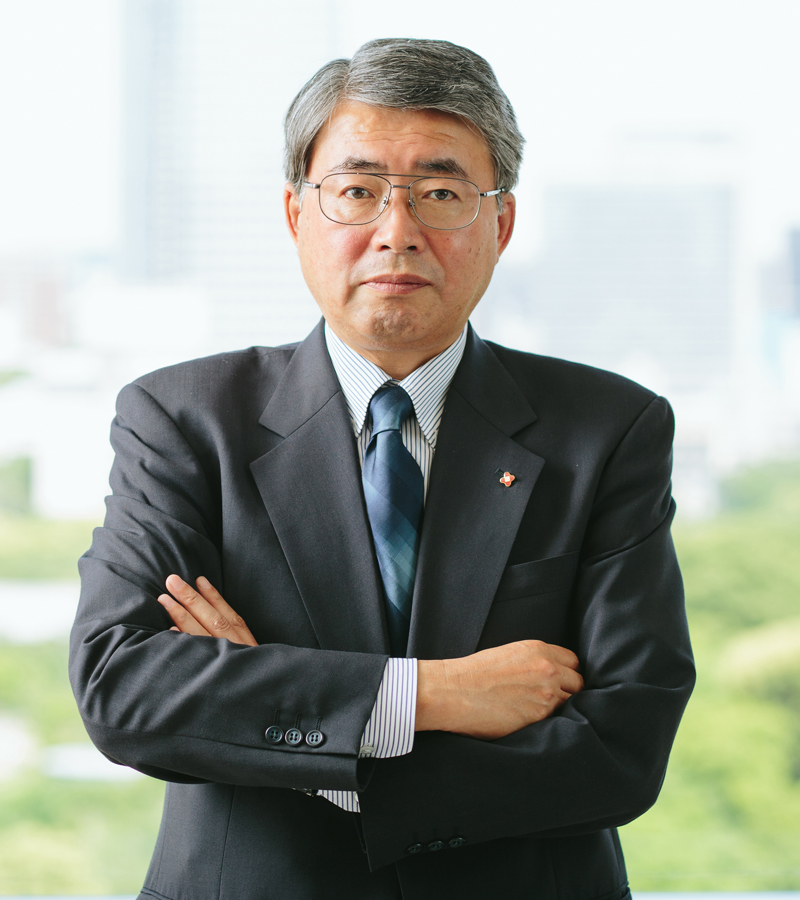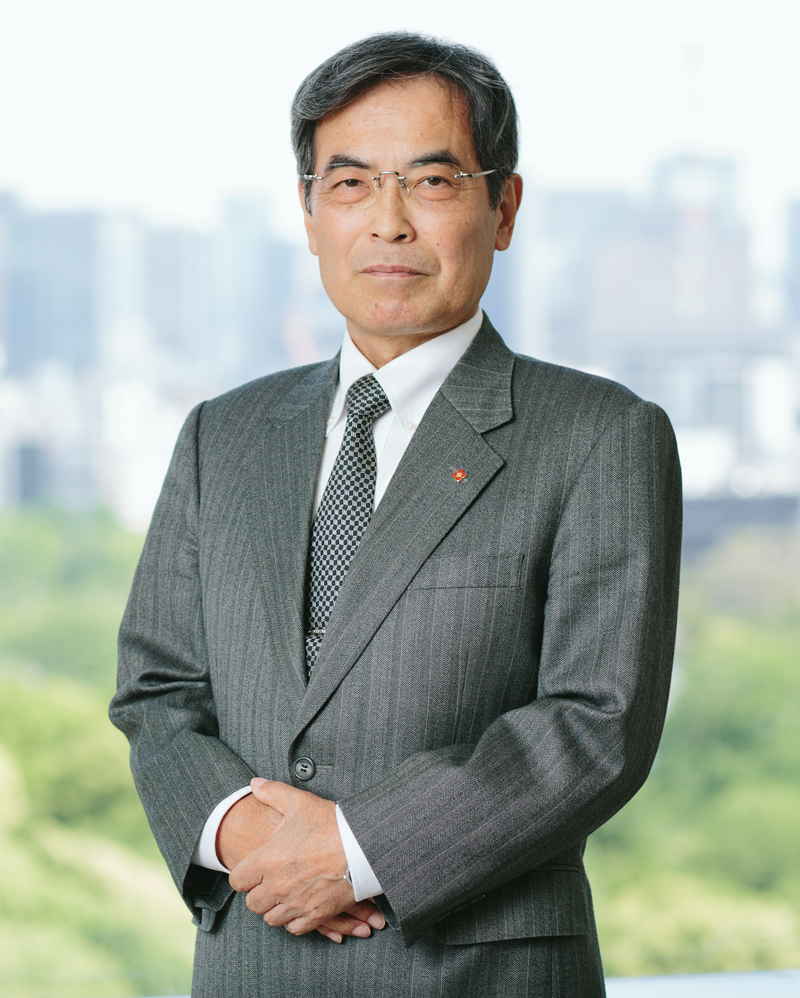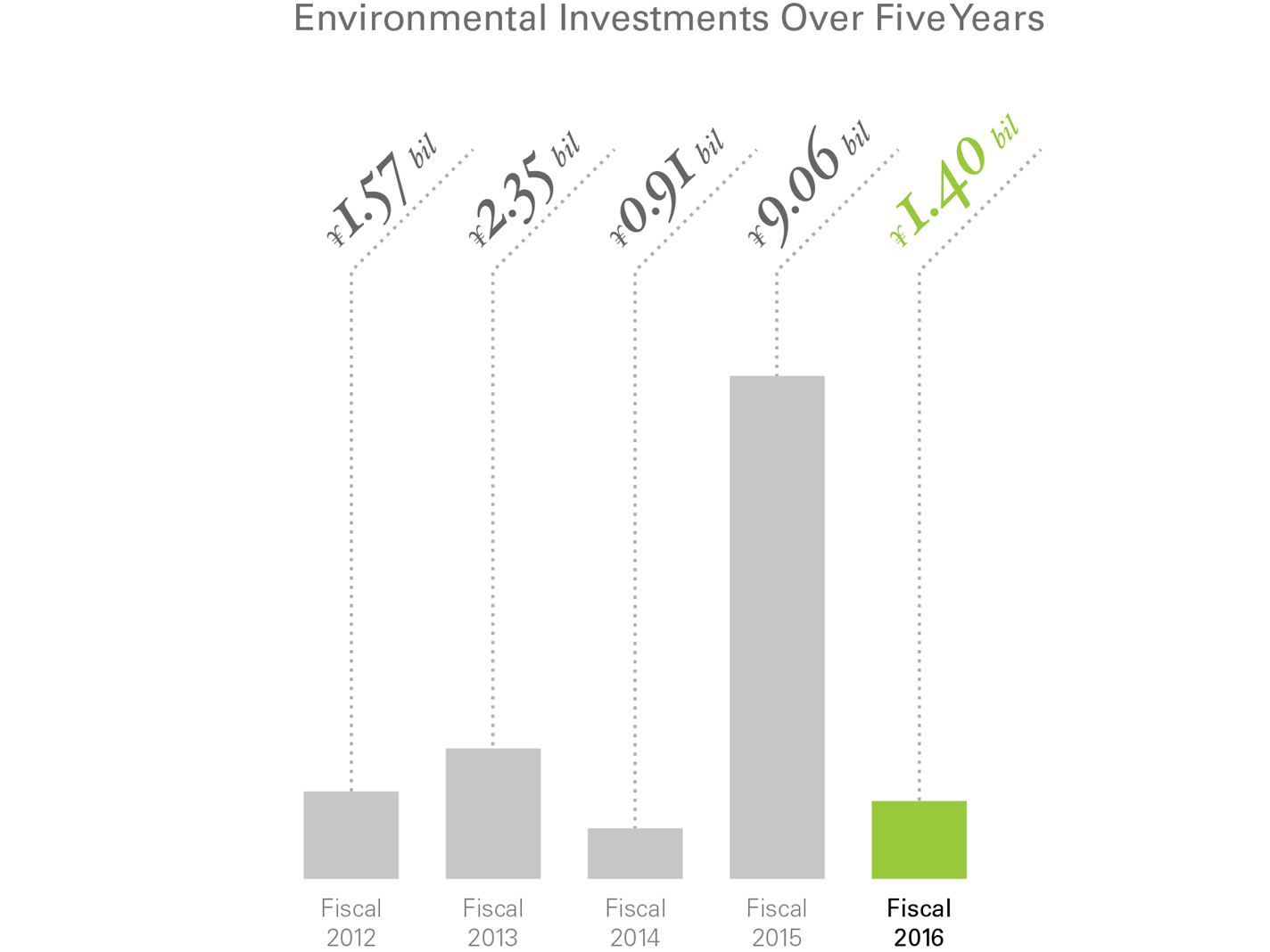President’s Message
Knowledge and effort are helping us make steady progress in implementing our three-year plan
Our basic Responsible Care (RC) policy in fiscal 2016 was to ensure highly focused, safe workplaces and to heighten the performance of our RC program. We saw improvements in our safety record during the year under review as a result of our safety activities, but unfortunately we were unable to achieve our goal of zero accidents and zero lost work-time incidents. It is our aim to continually improve our safety record while striving to expand and enhance the profitability of our business.
| Transitioning to Corporate Social Responsibility Reporting
In fiscal 1997, Tosoh began publishing RC reports to communicate its commitment to Responsible Care throughout the life cycle of its products. Our focus was on health, safety, and environmental considerations.
More recently, we have shifted that focus to the development of a governance system committed to optimizing our working conditions and workplace environments and to involvement with our local communities and other stakeholders. We are therefore replacing our RC reporting for fiscal 2016 with corporate social responsibility (CSR) reporting to better convey our activities in these areas.
We have also, for the first time in 30 years, drafted a medium-term business plan, chiefly in response to Japan’s Corporate Governance Code, which came into effect during our fiscal 2015. And in the context of introducing our CSR reporting, I also want to take the opportunity to present that 3-year plan.
Striving for a Year of Greater Growth
We are determined in the year ahead to implement our 3-year, medium-term business plan and to achieve its goals. Fiscal 2017 will be a year of greater advancements for Tosoh as it evolves further into a company with both strong commodity and strong specialty product lines.
|

Toshinori Yamamoto
Tosoh Corporation
President
|
We maintain a high operating capacity at those of our plants that produce long-lasting commodity products. But to continue to grow, we believe that it is necessary to augment plant production capacity, with new plant construction if need be; to increase the cost-competitiveness of our products; and to release increasingly high-value-added products.
Although we enjoy widespread market recognition for the functionality of our specialty products, we are also moving to realize a specialty business structure that is resilient to external factors. We are engaged in research and development (R&D) initiatives to produce technologies that meet our customers’ needs fully and quickly. This sees us bringing to market high-value-added and entirely new products.
Moving toward the Elimination of Accidents and Industrial Disasters
In November 2011, Tosoh experienced a major explosion and fire that resulted in tragedy. We resolved then to never allow such an accident to occur again, and over the past three years we have invested ¥10 billion to improve the condition of our plants. It is gratifying to see the fruits of our investments and efforts—our safety record is improving.
Going forward, we will convey technical skills to, provide training for, and encourage higher levels of awareness among our employees with regard to safety. We will, in short, continue to improve our workplaces. In fiscal 2017, visits will be made to the control rooms of the plants at our Nanyo and Yokkaichi Complexes in an ongoing effort to look for ways to ensure that our plant environments allow for work to be carried out in the calm, methodical manner required for safe operations.
Efforts and gains in safety at parent company operations notwithstanding, unfortunately there has been no reduction in industrial accidents at Tosoh Group companies. Employees there are no less important than employees at the parent company. So we will take every opportunity to ensure that the safety policies applied at the parent are likewise implemented at all group companies. Our goal, of course, is to eliminate accidents and disasters throughout the Tosoh Group.
Becoming a Company that People Trust
Realizing that goal will ultimately help us achieve our mission of being viewed by all as a reliable manufacturer of products that are safe and that contribute to society. That mission in mind, we are working diligently at our production bases to earn the confidence of the surrounding communities. Tosoh will continue to seek the trust of its stakeholders in its R&D, its manufacturing, its quality assurance, its logistics, and its products. And as always we look forward to your ongoing support and encouragement.
Message from the Chairman of the RC Committee
Our safety initiatives are beginning to bear fruit. We will build on these results while maintaining stable business operations.
At Tosoh, we engage in Responsible Care (RC) activities based on the RC activity guidelines discussed and decided by the RC Committee and on policies that we’ve devised in line with the needs of our business and research facilities. Implemented RC activities are monitored by our plant managers and the RC Committee chair. Responses to issues that emerge in the course of oversight are included in the activity guidelines for the following year through a PDCA (plan-do-check-adjust) cycle. In this way, we strive to ensure peace of mind for all through safe operations.

Keiichiro Nishizawa
Tosoh Corporation
Director, Executive Vice President
Chairman, RC Committee
|
Our safety record with regard to disaster prevention and occupational safety and health has unfortunately been such that we have not met our goal of zero incidents. But our safety efforts have begun to yield results, indicating that we are on the road to improvement. I believe, though, that continued gains in this regard make it vital that we carry out increasingly focused safety activities.
Environmentally, our operations have been without significant issues. Our acquisition, however, of Nippon Polyurethane Industry Co., Ltd., in October 2014 makes it necessary for us to proceed with our plans to reduce our atmospheric emissions of materials listed in Japan’s Pollutant Release and Transfer Register (PRTR).
There is similarly a greater need than ever before for us to assure product quality given the extent to which the mainstay of our business has shifted toward raw materials for specialty products. We need to prioritize tasks in our quality assurance system and even to rebuild that system to suit the changing structure of our business.
My wish is for Tosoh to engage in RC activities that recognize the importance of working hand in hand with everyone who handles Tosoh products and with our customers and the communities where our production facilities are located.
|
Environmental Accounting
Environmental cost-benefit accounting quantifies Tosoh’s environmental programs. In fiscal 2016, investments in environmental preservation amounted to ¥1.40 billion (US$12.4 million).

Health, Safety, Environmental Management
Principles Regarding the Environment, Safety, and Health
Tosoh Corporation contributes to the advancement of society through continuous innovation in chemistry, leading ultimately to the supply of products and services to the satisfaction of customers. At the same time, Tosoh continues to regard environmental protection, safety, and health as top management priorities.
Action Policies
Basic Stance
- Promote initiatives with an awareness of the obligation to comply with laws and regulations and self responsibility
- Set targets, draw up action plans, and implement actions with the participation of all concerned
- Incorporate audit results in future action plans
Environmental Protection Initiatives
- Conserve energy and resources through the use of the smallest-possible quantities of resources to obtain the greatest-possible benefits
- Reduce emissions and waste through improved manufacturing processes and operational management
Safety Assurance Initiatives
- Prevent accidents and respond to disasters through facility safety management
- Maintain and manage emergency response capabilities through safety drills
- Eliminate accidents and disaster effects through the analysis of case studies
Product-Related Environmental and Safety Assurance Initiatives
- Allow consideration for the environment, safety, and health to guide product design and the development of manufacturing processes
- Undertake prior assessment during the development of new products and processes
- Ensure product safety through total quality management
Communication Initiatives
- Provide safety management-related information for products and chemical substances
- Enhance public confidence through dialogue about business activities
Responsible Care Committee
Tosoh’s RC Committee guides and promotes the company’s RC activities. The committee is chaired by the director responsible for the company’s Environment, Safety and Quality Control Division, and its members include general managers from Tosoh’s Purchasing and Logistics Division, operating divisions, manufacturing complexes and offices, and research centers. The RC Committee devises an annual RC activity plan and presents it to Tosoh’s president. The president, in turn, presents the plan to the Board of Directors, which makes the final decision on the activities planned. Tosoh’s manufacturing complexes and offices subsequently flesh out the plan’s details and implement its planned activities.
Responsible Care Activities
Guided by core policies, Tosoh made progress with its various RC initiatives in fiscal 2016. The company improved its safety record, but, regrettably, incidents still occurred. In the year ahead, Tosoh will raise the level of its RC activities to achieve its main objectives of zero incidents and lost time.
Stewardship of Social Responsibility
We undertake to continuously innovate products that contribute to the sound development of society, to provide a reliable supply of our products, and to gain the trust of society.
We strive to be a prosperous business and a cooperative and contributing member of the local communities where we do business.
Preparedness for Major Earthquakes
The Great East Japan Earthquake of 2011 taught Japan’s Central Disaster Prevention Council and other groups that major earthquakes might occur and cause serious damage even where tremors are rare. Meetings in March and August 2012 produced conclusions about earthquakes and tsunami based on analyses of the Nankai Trough using megaquake models. Those conclusions, published in December 2013 and March 2014, included maps and more indicating the impact of tsunami on Yamaguchi Prefecture, home to Tosoh’s Nanyo Complex, and Mie Prefecture, home to Tosoh’s Yokkaichi Complex.
The Nanyo and Yokkaichi Complexes comply with all legal requirements, including Japan’s Construction Standards, High-Pressure Gas Safety, and Fire Service Laws. They are, with the exception of some electric power generation, designed to safely cease operation at a specified magnitude of earthquake.
Both complexes, moreover, have introduced measures and continue to plan more on an ongoing basis that prioritize saving lives. They hold comprehensive disaster prevention drills for earthquakes and have set up web cameras to enable the remote monitoring of conditions at each complex during a disaster. They have also assessed and reinforced as necessary the earthquake-resistance of facilities that have an important role under emergency conditions. In addition, they have in place countermeasures and evacuation procedures in the event of soil liquefaction caused by an earthquake and flooding caused by a tsunami. The complexes have as well stockpiled emergency supplies to sustain employees unable to return to their homes in the aftermath of a disaster.
Back to top»